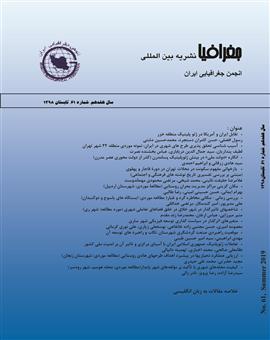مکان گزینی مراکز مدیریت بحران روستایی (مطالعۀ موردی: شهرستان اردبیل)
محورهای موضوعی :بهرام ایمانی 1 , حسن حسینی اميني 2 , رضا طالبی 3
1 - عضو هيات علمي دانشگاه محقق اردبيلي
2 - مرکز مطالعات پدافند غیرعامل
3 - دانشگاه محقق اردبیلی
کلید واژه: مکان گزینی, مرکز مدیریت بحران روستایی, شهرستان اردبیل مدل AHP مدل TOPSIS,
چکیده مقاله :
مخاطرات محیطی و انسانی یکی از اصلی ترین موانع تحقق توسعه پایدار بخصوص در سکونتگاه های انسانی (به ویژه روستاها) می باشد. در چند دهه اخیر با رویکرد مدیریت بحران استفاده از همه دستاوردهای مدیریتی، سازمان دهی و برنامه ریزی قبل از وقوع بحران با هدف مقابله با مخاطرات طبیعی و انسانی، امری عقلانی و الزامی می باشد. در مواجه شدن با بحران های احتمالی، یکی از ارکان اصلی مقابله و پیشگیری مناسب از اثرات منفی این نوع مخاطرات در نظر گرفتن مراکز مدیریت بحران است که همه اقدامات پیشگیری، آمادگی و مقابله، از جمله امداد رسانی، اسکان موقت حادثه دیدگان، در آن مهیا شود تا پیامدها را درباره ی بحران احتمالی به حداقل ممکن است. از این رو شهرستان اردبیل به علت واقع شدن در یک محدوده خطرپذیر طبیعی و دارا بودن تاسیسات صنعتی بزرگ قابلیت بالای شکل گیری مخاطرات طبیعی و انسانی را دارا می باشد. بنابراین در پژوهش حاضر با رویکرد توصیفی – تحلیلی و با استفاده از مدل تحلیل سلسله مراتبی (AHP) در نرم افزار ARC GIS به پهنه بندی محدوده شهرستان اردبیل در راستای جانمایی مراکز مدیریت بحران روستایی اقدام شد. در ادامه پژوهش با استفاده از مدل TOPSIS (8 معیار) به اولویت بندی اجرائی مراکز مدیریت بحران روستایی در محدوده منطقه مورد مطالعه اقدام شد. نتایج پژوهش نشان می دهد که 13.3 درصد از اراضی شهرستان اردبیل بالاترین قابلیت برای استقرار مراکز مدیریت بحران را از خود نشان می دهد. با توجه به پهنه های بهینه مشخص شده، 7 موقعیت برای استقرار مراکز مدیریت بحران در محدوده مورد مطالعه مشخص شد و با استفاده از مدل TOPSIS به اولویت بندی این مراکز اقدام شد و نتایج نشان داد که پایگاه شماره 2 بالاترین قابلیت و پایگاه شماره 1 کمترین قابلیت برای استقرار مرکز مدیریت بحران را از خود نشان داد.
Environmental hazards are one of the main obstacles to the achievement of sustainable development, especially in human settlements (especially villages). Over the past decades, with the crisis management approach, the use of all management achievements, organization and pre-crisis planning to deal with hazards Natural and human is rational and necessary. In dealing with emerging crises, one of the main pillars of proper coping and prevention of the negative effects of these hazards is the inclusion of crisis management centers, which include all prevention, preparedness and response measures, including relief, temporary accommodation of the incident, in which It is possible to minimize the consequences of a possible crisis. Hence, the city of Ardabil, due to being located in an area of seismicity and its location in the border area of the country, has a high potential for the development of non-human hazards. Therefore, in this study, using a descriptive-analytical approach, using the Hierarchical Analytic Model (AHP) (13 criteria), the area of Ardabil city was zoned in order to locate Rural Crisis Management Centers and using the TOPSIS (8 criteria) model Prioritization of Rural Crisis Management Centers was conducted within the study area. The results of the research show that 13.3% of the land in Ardebil has the highest ability to establish crisis management centers. With respect to the specified areas, 7 locations for the establishment of crisis management centers were identified and the TOPSIS model was used to prioritize these centers and the results showed that the base number 2 has the highest capability and the base number 1 Featuring the lowest capacity for deployment of crisis management center
